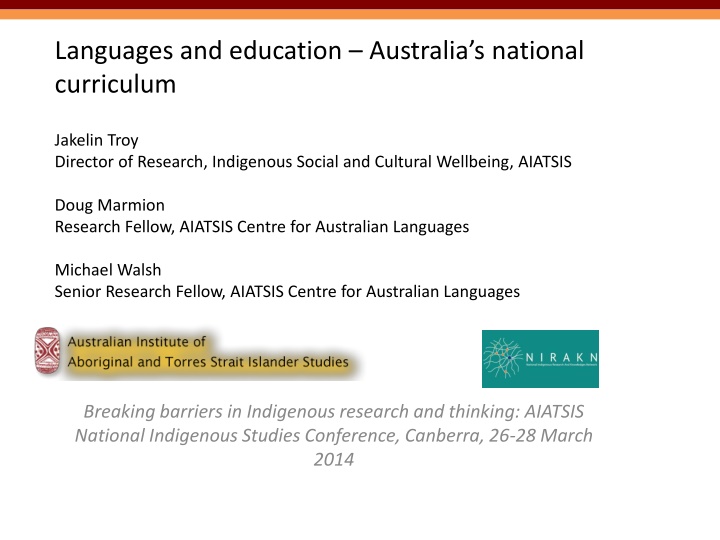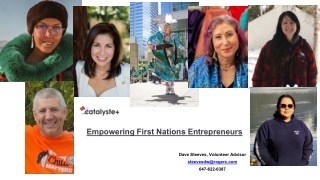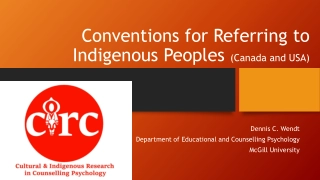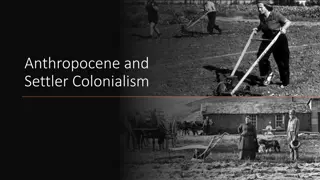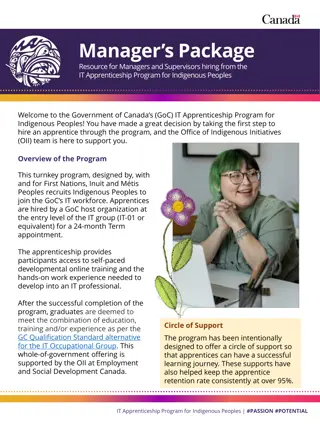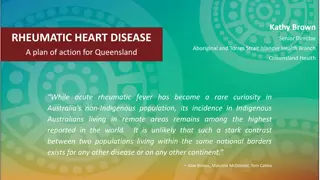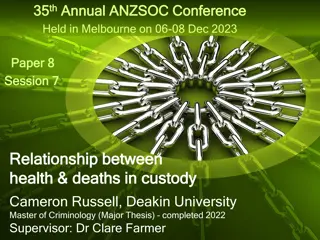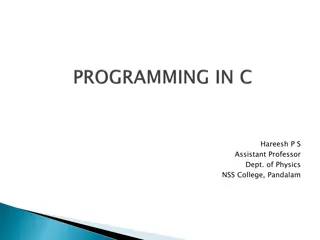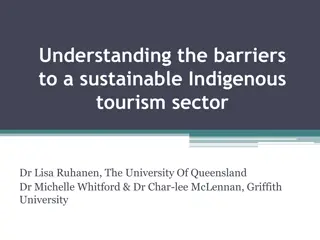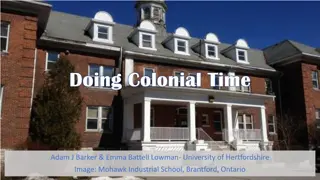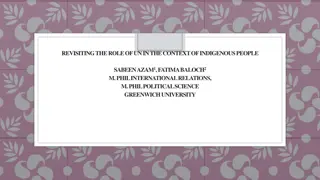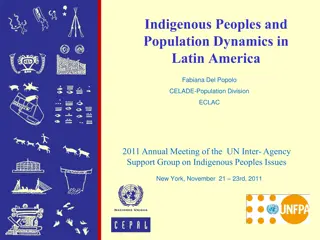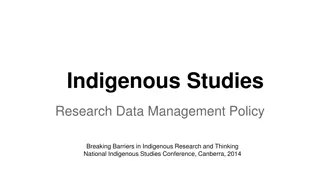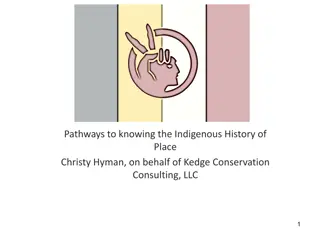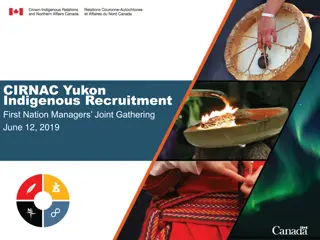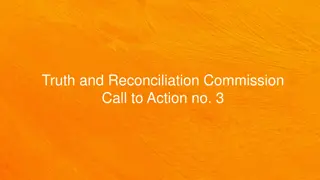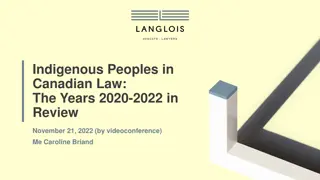Preserving Australian Indigenous Languages in Education
The development of the Framework for Aboriginal Languages and Torres Strait Islander Languages in the Australian Curriculum aims to give equal representation to Australian languages alongside other world languages in schools. This initiative helps preserve, document, and maintain indigenous languages while offering all children a deeper understanding of Aboriginal and Torres Strait Islander peoples. By valuing these languages in schools, students, especially indigenous children, experience increased self-esteem and engagement with education, enhancing their learning experiences.
Download Presentation

Please find below an Image/Link to download the presentation.
The content on the website is provided AS IS for your information and personal use only. It may not be sold, licensed, or shared on other websites without obtaining consent from the author.If you encounter any issues during the download, it is possible that the publisher has removed the file from their server.
You are allowed to download the files provided on this website for personal or commercial use, subject to the condition that they are used lawfully. All files are the property of their respective owners.
The content on the website is provided AS IS for your information and personal use only. It may not be sold, licensed, or shared on other websites without obtaining consent from the author.
E N D
Presentation Transcript
Languages and education Australias national curriculum Jakelin Troy Director of Research, Indigenous Social and Cultural Wellbeing, AIATSIS Doug Marmion Research Fellow, AIATSIS Centre for Australian Languages Michael Walsh Senior Research Fellow, AIATSIS Centre for Australian Languages Breaking barriers in Indigenous research and thinking: AIATSIS National Indigenous Studies Conference, Canberra, 26-28 March 2014
Overview and acknowledgement We begin with an acknowledgement of the traditional owners on whose country we meet. Our presentation today is about the development of the Framework for Aboriginal Languages and Torres Strait Islander Languages being written for the Australian Curriculum Assessment and Reporting Authority. This initiative means that our Australian languages are being given an equal representation along with all the other world languages taught in our schools as part of the new Australian Curriculum Languages. Through this action schools and systems are helping to preserve, document and maintain our languages. They are also giving all children the chance to gain a greater understanding of the worlds of Aboriginal and Torres Strait Islander peoples. Perhaps most importantly the value for Aboriginal and Torres Strait Islander children is that they are able to see our languages and our cultures valued in schools in a way that is rarely evidenced. All the evidence is clear that our children experience a marked increase in self esteem and engagement with education and learning in schools when our languages are part of the curriculum.
Who are we Jaky Doug Michael
Preliminary comments on Australian languages Since Australia was invaded by the British in 1788 most of our 250 language have gradually gone to sleep . Many social and government policy factors have contributed to the demise of our languages. Now only about 20 are still spoken right through . Most of our languages are now being reawoken. Schools and education systems can play a crucial part in helping us to revive and maintain our languages.
Ecologies of Australian languages Our languages are diverse, broadly divided into two large categories Pama Nygungan and Non-Pama Nygungan each with quite different features. Language groups vary in size across Country (the territory in which each language is used) and speaker numbers. Some were always languages with few speakers as few as small family groups of 40 people others had several thousand speakers and belonged to much larger social groupings. All languages had multiple dialects and usually languages were divided into sub languages that were used in different domains such as women s or men s secret language, mother-in-law language used between a man and his mother-in-law through and intermediary, song language, love poetry, children s language etc. Traditionally Aboriginal and Torres Strait Islander peoples were multi-lingual and used as many as 5 or 6 languages every day for communicating with their families and the wider society. Of the small number of languages still spoken right through these are also slowly losing the more complex features of their grammatical constructions and many domains of vocabulary, particularly complex knowledge about the country, its plants, animals and seasons. The remaining 230 or so languages which are not spoken right through are referred to generally by our peoples as sleeping , waiting to be woken up by their communities of owners. Some rest in the archives of great collections like those held in my own organization AIATSIS, thousands of miles of audiovisual recordings and huge volumes of texts. Others are beginning to wake up as their communities undertake research and work with their Elders to recover understanding of how the languages were spoken. Some are very far advanced in this reawakening and are now being spoken again. These have increasingly sophisticated materials available to their communities and other people who want to relearn their languages and become involved in developing them as languages of everyday communication.
Writing a framework for teaching 250 languages With so many languages and with such varied ecologies it is impossible to write, at a national level, individual language curricula. The key to the beginning of the process for thinking about how to handle so many languages is contained in the document that guides the writing of all language curricula for ACARA the Shape of the Australian Curriculum Languages (http://www.acara.edu.au/verve/_resources/Languages_- _Shape_of_the_Australian_Curriculum.pdf). This document created the foundation for a new way of teaching languages in Australia and centralised our Australian languages within the curriculum. For the first time in our recent history we can look forward to our languages taking their place alongside all other languages taught in Australian schools. Decisions about which languages to teach and how they will be taught will be a process of involving our communities with schools and systems and will be made collaboratively with local Aboriginal and Torres Strait Islander people. This is enshrined in the protocols established in the Shape Paper and and written very specifically as a core part of the Framework.
A Learner Pathway approach In thinking through how to create the basic architecture for our Framework we realised that it was necessary to develop an approach that would accommodate the whole range of ecologies of the languages and the range of different background knowledge learners will bring to the classroom. Clearly first language speakers of an Australian language would need a different approach to teaching their language than would a student learning the same language as a second language. One needs enrichment and language extension building on their knowledge as a speaker. The other needs to learn to acquire the language, to be taught from the beginning. The Chinese language curricula which was being developed as one of the first 2 (the other was Italian) also struggled with a range of learners not necessarily crucial to the considerations of other language curriculum writers. It has long been a problem for teachers of Chinese in Australian schools that a growing cohort of learners are fully competent speakers and are also highly literate. These are students who have emigrated to Australia from China having acquired their first language and literacy in Chinese. Similarly, Australian languages have a cohort of first language speakers and a range of others who might be partial or non-speakers when entering the language classes. With Chinese as the inspiration we settled on a range of Learner Pathways with descriptions of content, scope and sequence across the years of schooling from Framework (entry level) to Year 10. In the future we will also be able to cater for the final 2 years of secondary schooling that are the entry point for tertiary education.
First Language Learner Pathway (L1) First Language Learner Pathway (L1) designed to cater for students who are growing up with one of the Australian languages as their first language. These students speak one or more of the last 20 or so languages which are still spoken across all generations and for all communicative purposes. These students will be almost exclusively Aboriginal or Torres Strait Islander because the communities in which they live are almost exclusively of their own people. Very few non-Indigenous people live in these communities. The students in this pathway will be taught about their language and its use with a particular emphasis on developing literacy skills as these are generally substantially lacking amongst this cohort of students. Learning to read and write in their own languages will help them to develop these skills and to use their knowledge in acquiring English and English literacy. English is the National Language of Australia and dominates our education system. All students are expected to become fluent in English.
Revival Language Learner Pathway (LR) Revival Language Learner Pathway (LR) designed to provide students with a working knowledge of one of the languages which are being reawoken by their communities. This pathway has a particular emphasis on developing the skills of its learners in the areas of language building and the linguistic techniques relevant to language revival. There is no less emphasis on students learning to use the language for communication. However, in doing so they will be developing knowledge of how to reconstruct grammatical and lexical information that might be lacking in the language corpus. This pathway is not exclusively for Indigenous students but will have a particular appeal to students from the language community who are keen to become involved in reviving a sleeping language .
Second Language Learner Pathway (L2) Second Language Learner Pathway (L2) designed to provide students with an opportunity to learn one of the languages which are still spoken right through . Potentially these students can visit communities where the language is spoken and learn it in part through and immersion program. It is designed to provide a way for all students in our schools, Indigenous or not, to have an opportunity to learn an Australian language.
Cross-Curriculum Priorities Aboriginal and Torres Strait Islander histories and cultures Asia and Australia s engagement with Asia Sustainability 13
Cross-Curriculum Priorities The Australian Curriculum is designed to meet the needs of students by delivering a relevant, contemporary and engaging curriculum that builds on the educational goals of the Melbourne Declaration. The Melbourne Declaration identified three key areas that need to be addressed for the benefit of both individuals and Australia as a whole. In the Australian Curriculum these have become priorities that provide students with the tools and language to engage with and better understand their world at a range of levels. The priorities provide dimensions which will enrich the curriculum through development of considered and focused content that fits naturally within learning areas. They enable the delivery of learning area content at the same time as developing knowledge, understanding and skills relating to Aboriginal and Torres Strait Islander histories and cultures, Asia and Australia s engagement with Asia or Sustainability. Incorporation of the priorities will encourage conversations between learning areas and between students, teachers and the wider community. http://www.acara.edu.au/curriculum/cross_curriculum_priorities.html 14
Aboriginal and Torres Strait Islander histories and cultures The Aboriginal and Torres Strait Islander histories and cultures priority provides the opportunity for all young Australian s to gain a deeper understanding and appreciation of Aboriginal and Torres Strait Islander histories and cultures, deep knowledge traditions and holistic world views. This knowledge and understanding will enrich all learners ability to participate positively in the ongoing development of Australia through a deepening knowledge and connection with the world s oldest continuous living cultures. The Aboriginal and Torres Strait Islander histories and cultures priority has been developed around the three key concepts of Country/Place, Peoples and Cultures. Each concept contains a number of organising ideas that provide a scaffold for developing related knowledge, understanding and skills. These are embedded in each learning area according to the relevance of its content to the organising ideas. An organising idea may draw on content from more than one learning area. Taken as a set, the organising ideas provide a coherent framework for the priority. 15
Aboriginal and Torres Strait Islander histories and cultures: key concepts The first key concept highlights the special connection to Country/Place by Aboriginal and Torres Strait Islander Peoples and celebrates the unique belief systems that connect people physically and spiritually to Country/Place. The second key concept examines the diversity of Aboriginal and Torres Strait Islander Peoples culture through language, ways of life and experiences as expressed through historical, social and political lenses. It provides opportunities for students to gain a deeper understanding of Aboriginal and Torres Strait Islander Peoples ways of being, knowing, thinking and doing. The third key concept addresses the diversity of Aboriginal and Torres Strait Islander societies. It examines kinship structures and the significant contributions of Aboriginal and Torres Strait Islander people on a local, national and global scale. 16
Science, Maths and Indigenous Perspectives The Australian, 13 March 2014 http://www.theaustralian.com.au/national-affairs/policy/warren-mundine- indigenous-culture-in-maths-nonsense/story-fn9hm1pm- 1226853056250# Warren Mundine: indigenous culture in maths nonsense The head of the Prime Minister's indigenous council, Warren Mundine, has criticised the embedding of indigenous culture in all subjects, arguing that science, maths and physics should be taught without any cultural perspectives.
Science, Maths and Indigenous Perspectives The Guardian 18 March 2014 http://www.theguardian.com/commentisfree/2014/mar/18/warren-mundine-indigenous-science-curriculum Dawn Casey: Warren Mundine, of course science needs an Indigenous perspective To say that Indigenous culture should be kept out of maths and science teaching will only ensure that fewer children study it. Last week, Warren Mundine, head of the prime minister s Indigenous council, was quoted in the Australian as saying that it is ridiculous to include an Indigenous culture perspective in the teaching of science and maths. Mundine said: I agree with Christopher Pyne, I think in some areas we have got ridiculous. What is Indigenous physics? Physics is physics. If we are to compete in the job market we must learn technology and engineering, we need to be taught subjects properly. I agree that we need to reassess the curriculum because we need real units that teach the subjects without this ridiculous insertion of culture, the idea that you have to have an indigenous or Asian perspective, to be frank, is silly. The sciences and maths should be taught properly.
Mundines comments add nothing to the very important debates on what should be included in the national curriculum and how children, regardless of their cultural background, should be taught. They ignore that culture permeates everything we do including maths and physics and reinforces stereotypical views that Indigenous culture is only about language, kinships systems and hunting and gathering important as they are. It is well known that all developed countries including Australia are facing a crisis asdiminishing numbers of students study mathematics, physics and other science subjects. We also know of the difficulties confronting government and Indigenous communities regarding school attendance. One of the key strategies is surely to look at how we engage students in learning. For centuries, people from all cultural backgrounds have been developing ideas and solving problems. Euclid who lived in Alexandria more than 2000 years ago laid the foundations for mathematics. Australia s Aboriginal people represent the longest-
living culture on earth. It is incredible that our culture should be treated as a stand-alone subject or as part of the humanities. In reading the article I was reminded of previous views that attributed the striking Wandjina figures of Kimberley art to Egyptians, Hindus or creatures from outer space. Once they were accepted as Aboriginal, they were labelled as native art or folk art or just Aboriginal art, not world art. The current debate surrounding the national curriculum misses a number of fundamental issues: how do we engage and encourage our young people in areas such the sciences and
how do we give them an understanding and appreciation of the depth of our Indigenous peoples ingenuity? These are not mutually exclusive. Just a couple of examples of how Indigenous people used science include the development of the boomerang and other sophisticated weapons; traversing this great continent without compasses; managing country through controlled burning and ethno-botanical knowledge linked to specific places and environments. To go back to a time when Aboriginal and Torres Strait Islander culture was put into an ethnographic box, as some sort of anthropological curiosity, and excluded from the breadth of mainstream knowledge, including maths and science, is to disadvantage all Australians. [my emphases]
Asia and Australias engagement with Asia The third key concept addresses the nature of past and ongoing links between Australia and Asia, and develops the knowledge, understanding and skills, which make it possible to engage actively and effectively with peoples of the Asia region. ACARA has consulted both with educators who have deep knowledge of the Asia region and organisations like the Asia Education Foundation in developing this specific cross curriculum priority. It has also involved practising teachers from learning areas and with expertise in Asian Studies to provide advice about how the priority could be incorporated into each learning area. 22
Sustainability ACARA has consulted both with educators who have deep knowledge of Sustainability and organisations such as National Education for Sustainability Network, the Australian Association of Environmental Educators and the Australian Youth Climate Coalition in developing this specific cross curriculum priority. It has also involved practising teachers with expertise in Sustainability from each of the learning areas to provide advice on how the priority could be incorporated into each learning area. http://www.acara.edu.au/curriculum/cross_curriculum_priorities.html
General capabilities General capabilities are a key dimension of the Australian Curriculum. They encompass knowledge, skills, behaviours and dispositions that, together with curriculum content in each learning area and the cross- curriculum priorities, will assist students to live and work successfully in the twenty-first century. They play a significant role in realising the goals set out in the Melbourne Declaration on Educational Goals for Young Australians (MCEETYA) 2008 that all young people in Australia should be supported to become successful learners, confident and creative individuals, and active and informed citizens. The Australian Curriculum includes seven general capabilities. These are: Literacy Numeracy Information and communication technology capability Critical and creative thinking Personal and social capability Ethical understanding Intercultural understanding.
Inclusivity http://www.acara.edu.au/verve/_resources/General_ Capabilities_-_Consultation_Report_- _December__2011.pdf, p. 16
Intercultural Understanding http://www.acara.edu.au/verve/_resources/General_Capabilities_ -_Consultation_Report_-_December__2011.pdf, p. 42
Values and Beliefs http://www.acara.edu.au/verve/_resources/General_Capabilities _-_Consultation_Report_-_December__2011.pdf, p. 29
Conclusion While there are many similarities between the pathways, each is distinct in a number of important respects, including: the knowledge that the students bring, the ecology of the language and the status of the speech community and the relationship of the students to the speech community. Each pathway will provide schools, teachers and students with the opportunity to play an active role in reviving and maintaining our languages into the future. In order to give teachers greater guidance on how to prepare curriculum we plan to provide examples of how the Framework can be used to develop individual curriculum in each of the Pathways and for each of the two main language groups Pama Nyungan and Non-Pama Nyungan. In the middle of 2013 the Draft Framework was put online by ACARA for consultation and also taken to 20 face to face meetings with Aboriginal and Torres Strait Islander communities, schools and teachers across Australia. Michael Walsh and I attended many of these meetings to assist in the consultations. The outcome was resounding support for the Framework. It was described by many Aboriginal and Torres Strait Islander people as monumentally important for all our communities, heralding a complete change in the attitude towards our languages. We anticipate that following some revisions the Framework will be available on ACARA s website for use in schools next year. In finishing I hope we have awakened your interest in this ground breaking research in Australia which is leading to our first national Australian Curriculum which will provide a way forward for all schools to teach our own Australian languages.
